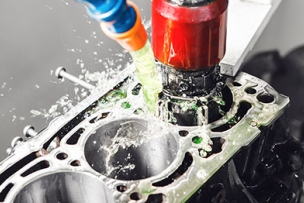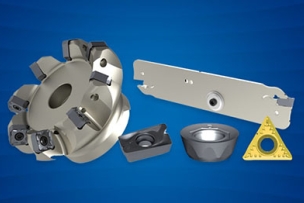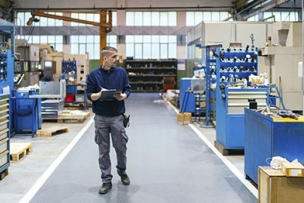To meet these changing needs, metrology equipment makers are introducing sophisticated digital equipment that can consistently achieve submicron measurements without requiring highly specialized training to use it.
Case in point: TESA’s Twin-T20 remote digital display unit.
Greater Ease = Increased Productivity
“With tiny tolerances growing higher and higher, you need tools that can do quality control in an easy, quick way rather than in a complicated manner,” says Uwe Burkardt, marketing director for TESA Technology, which is headquartered in Switzerland.
The Twin-T20 measures distance and diameter and can also check shape or orientation tolerances, such as straightness, run-out, parallelism and perpendicularity. It enables a machine operator to connect two probes and simultaneously display two color-coded measured values.
If both sensors are green, the part is inside tolerance. If one or both sensors are red, the part is out of tolerance. (A newer unit, called the Twin-T40, can connect four probes at the same time.)
Burkardt says the goal was to create a tool that makes measurement easy, even for someone who is not a fully trained quality control professional. “People like that the display gives a clear feedback with colors. It’s easy to understand if something is OK or not OK,” Burkardt says. “The feedback we get from many customers is that it’s as easy as a traffic light.”
The 7-inch touchscreen display enables users to choose from five different options: bar graph, dial indicator, rotating indicator, numerical indicator and galvanometer.
The triangle shape of the display unit’s base was chosen for its sturdiness. “We needed a stable basic shape to support the touchscreen, which is important in the production environment so that the display remains secure,” Burkardt says. “We like to call it the Toblerone because it’s the same shape as our famous Swiss chocolate.”
Because the display unit delivers fast results and can be used by nearly everyone, it can help increase productivity, especially in small- to mid-sized companies that aren’t big enough to have a coordinate measuring machine (CMM).
“Measurement is always difficult because it costs money, but nothing is created,” Burkardt says. “But if you’re a small company producing a special part for a bigger company and your goods come back because they are not in spec, that’s a huge problem.”
Connected and Compatible
TESA Technology product manager Fabrice Maiorana says the multiple integrated USB ports on the back of the display unit allow it to function like a small computer in a manufacturing workplace.
“It can be connected to a computer via a USB cable, or via Bluetooth, and you can also send data to a USB stick,” Maiorana says. The last option is ideal for small companies that don’t have computers in the workshop.
By capturing and sharing data automatically, rather than having to rely on writing measurements down or typing them into an Excel spreadsheet, you eliminate the possibility of missing or inaccurate data, as well as lost time due to having to manually enter information, he says.
Since most manufacturers are not faithful to just one brand of metrology equipment, the display unit can also connect to a wide range of measuring devices such as micrometers, calipers and dial gauges made by other companies.
“One of the biggest strengths, we think, is that it’s open and not limited to just one type of instrument,” Maiorana says. “In this way it really functions as a ‘measuring station’ that’s able to fully meet the customer’s requirements.”
An Added-Value Function
One benefit of the display unit is that it can simplify and speed up the process of classification, where parts are identified and sorted based on even tinier tolerances inside the main tolerances. These kinds of tiny tolerances are often required when two components need to be paired together.
“If you have a tolerance that’s between +2 microns and -2 microns, for example, you can set up even tinier tolerance ranges within that range and assign them different colors,” Burkardt says. “Then, when the corresponding color is displayed, the employee just places the component in the box marked with that color.”
Overcoming Barriers to Adoption
Burkardt says the biggest obstacle to convincing manufacturers to use the display unit isn’t technology, but rather a reluctance to change their mindset and work processes, even if they are slower and antiquated like entering numbers on a paper spreadsheet.
“Measurement and quality control is really old school, and we still have in our portfolio a lot of technology equipment that is 40 and 50 years old,” he says. “A company will say, ‘This is how we’ve done it for many years, and it still works fine for us, so why change?’”
When manufacturers are hesitant about making the switch, TESA encourages them to start by using the galvanometer display on the Twin-T20. This looks exactly like the display on the older TT20 unit that it replaced, which was on the market for more than 25 years.
“We like to call that ‘bridge marketing.’ It’s a way to help make the transition easier for people,” Burkardt says. However, he says that once companies start using the display unit, they quickly switch to the more modern displays.
One unexpected finding is how people are using the touchscreen. “When we first introduced this unit, we thought workers would want to use the pencil [stylus] rather than their dirty fingers, but nobody is ordering the pencil. Today, people are so comfortable using smartphones that everybody just uses their fingers,” Burkardt says.
To help companies get up to speed on the display unit, and in a nod to younger workers—who are much more likely to watch a quick video than read a lengthy user manual—TESA has created a series of video tutorials that are one to two minutes long for what’s called TESA Technology Academy, covering topics such as data output, classification and other functionalities.
Have precision metrology tools improved productivity in your business? Tell us in the comments below.





Talk to Us!
Leave a reply
Your email address will not be published. Required fields are marked *